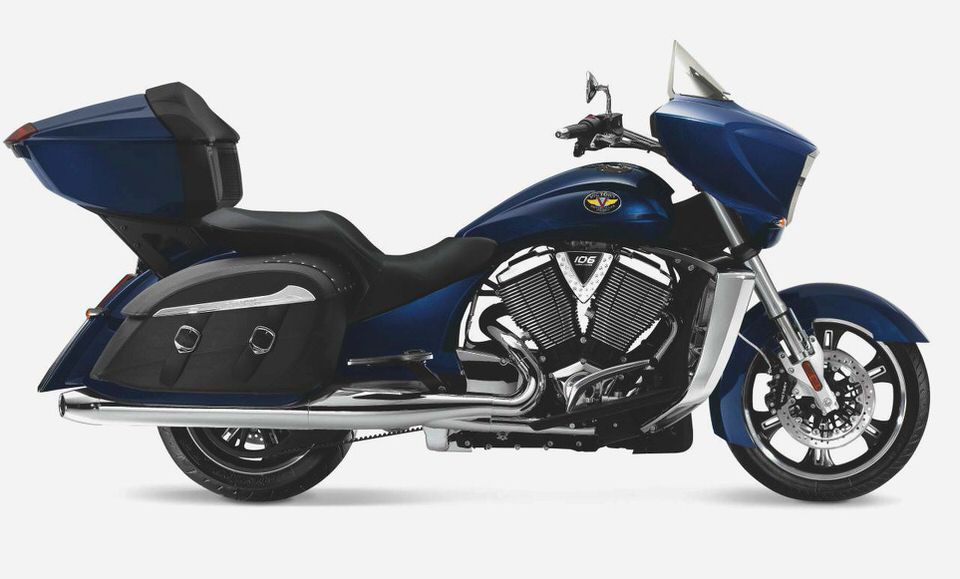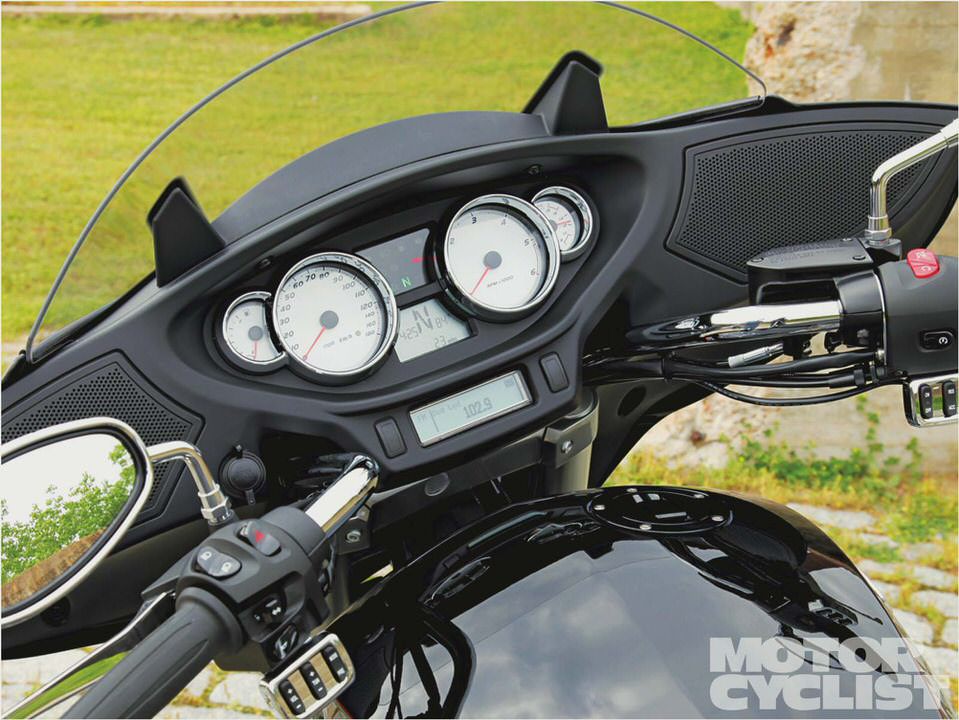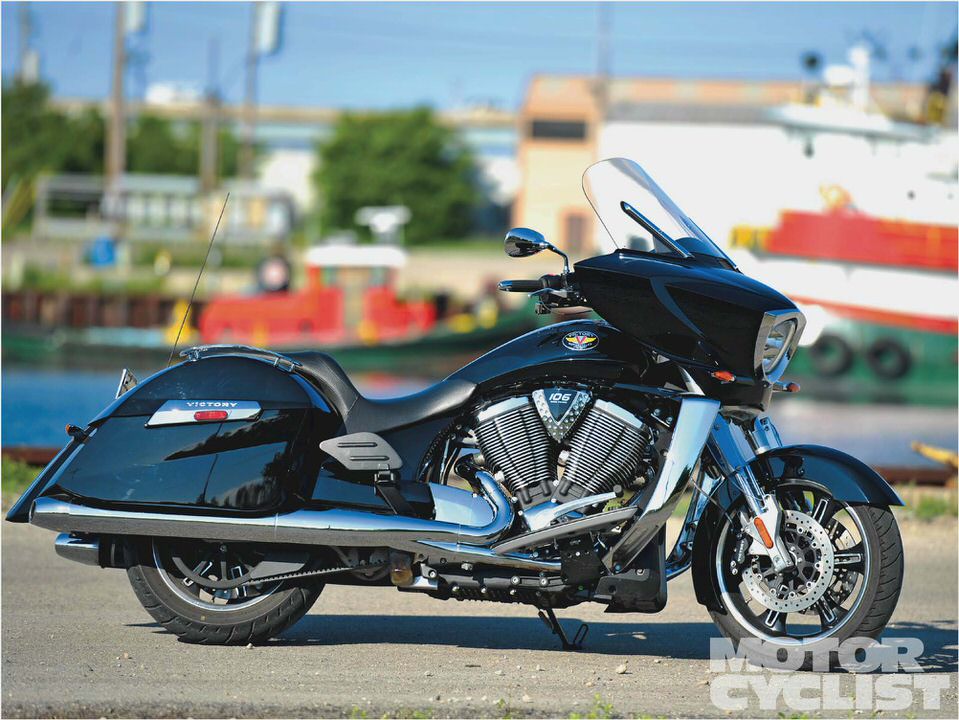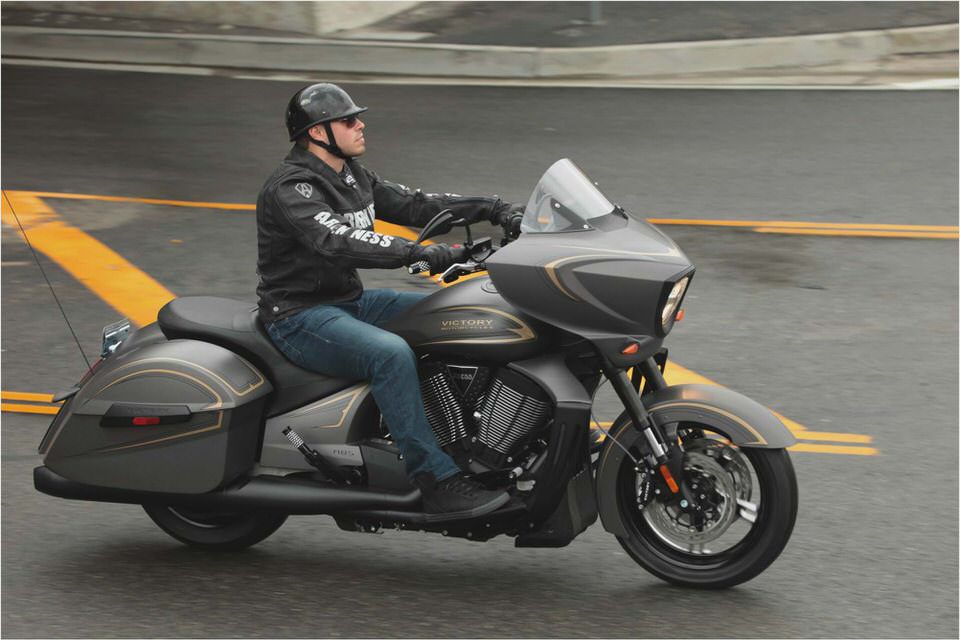
2012 Victory Cross Country Tour Review
The news that Victory would introduce a full-on Tour version of the company’s Cross Country for 2012 instantly got our attention. Not only because we liked the standard version of the bike, also because it would provide the Cross Country with better luggage capacity than its bigger Vision stablemate without that bike’s substantial weight and controversial styling.
Since the whole touring line from Victory is powered by the same 106-cubic-inch Freedom 106/6 V-twin, which cranks out 92-horsepower and 109 pound-feet V-twin, the lighter the bike the better. Unfortunately, as we were to find out, the advantage enjoyed by the Cross Country over the Vision shrinks somewhat with the addition of new front fairing lowers and the 17.7-gallon Lock Ride rear trunk.
The Cross Country Tour now weighs in dry at 845 pounds (it actually weighs more when brimming with necessary fluids) versus the Vision’s 869 pounds. The addition of the top box also raises the bike’s center of gravity (particularly when full of gear) so that it manifests the slightly top-heavy sense of many heavyweight tourers.
Since most of the contributors to the increased weight are the useful accessories that define the Tour model—the lower fairing panels and their one-gallon storage boxes and manually adjustable vent systems, that 17.7-gallon trunk box, and the comprehensive audio, cruise control and standard ABS systems—it’s hard to find fault with the Tour’s increased avoirdupois. Particularly when the extra mass adds stability on a long open road.
And this is a great machine to ride long distances if you like the classic American V-twin format. Victory’s air-and-oil cooled V-twins are sophisticated engines with seamless fuel injection, single-overhead cam valvetrains, and pretty refined operation. Improvements made to the transmissions last year—along with the quiet belt drives employed across the range—help contribute an overall sense of powertrain quality.
Raising the windscreen by a full 8.75 inches has all but eliminated the nasty buffeting that afflicted taller riders on previous Cross Country models. I once rode to Las Vegas from L.A. on one and had to ride in the slow lane at less than 80 mph to stop my vision from jumping, so bad was the aerodynamic turbulence behind the windshield.
Now I can run an indicated 100 mph on the new Tour before the buffeting even begins to bounce my glasses around. The protection is almost too good. Even with the fairing deflectors and lower panel vents deployed to cool the rider, the introductory ride in the Wasatch mountains around Park City, Utah was a warm affair.
And it was not helped by the sight of helmet-less Utah riders parading past in t-shirts and shorts.
Deflectors below the fairing channel air to the rider. There are vent panels in the fairing lowers, too.
But the bike handled the meandering roads extremely well. With the air pressure in the rear shock pumped to 35psi and a claimed lean angle of 32-degrees, my bike never dragged its footboards once. This despite a brisk pace set by Victory’s enthusiastic staff members.
And that rear shock strut provides nearly five inches of travel, avoiding the sudden spinal compression that often accompanies abrupt bumps encountered while riding in an upright position.

The one-piece aluminum frame is clearly pretty stiff, and the sportbike-like inverted fork and rear shock are well up to the task of maintaining a flat and even ride. Dual discs up front provide adequate braking on this hefty chunk of metal, but require a really strong squeeze and assistance from the rear brake to produce intense deceleration. Linked ABS is now standard on all Victory tourers.
All of this should be seen in context of the Cross Country’s real role—that of swallowing hundreds of miles a day with accompanying luggage capacity (at over 41 gallons) that is claimed by Victory to be the best in the industry. While the big 106 cubic-inch (1,731cc) V-twin’s horsepower seems puny in comparison to sport literbikes, the engine’s broad torque spread makes it a pleasure to use.
The thing pulls fairly smoothly from almost any engine speed, making for a relaxed experience. While uphill passes at high elevations highlighted the bike’s relatively modest output, the return is good fuel mileage and a beautifully unhurried highway demeanor. Besides, if you’re looking for arm-stretching thrust, this bike is in the wrong category.
While the split-level seat dictates where the rider’s butt will rest with little variation, the shape and padding proved comfortable on even very long stretches. One of the writers present at the event rode home (to California) from Park City (via Sturgis), and reported on Facebook that he’d covered over 800 miles in one day without feeling sore.
Helping riders stay alert for long distances is the bike’s onboard audio system, complete with iPod (or iPhone) connectivity. The onboard speakers turn out to be surprisingly clear on the move, thanks to the comprehensive wind protection afforded by that big handlebar fairing, generous lower bodywork and tall windshield.
We like that the Cross Country Tour features modern touches like an HID headlight, LED turn signals, and an overhead cam engine, all the while conforming to the all-American big twin format. To that you can add adjustable passenger footboards, heated grips and seats, and cruise control. Overall, it’s an appropriate combination, we think.
At $21,999, the Cross Country Tour isn’t the cheapest tourer on the road, but it certainly does not lack features, character, or style.





- 2012 Victory Cross Country Tour Preview – Ultimate MotorCycling
- Test ride – Victory Vegas and Vegas Jackpot The World Through My Lens
- 2014 Victory Cross Country Tour Review
- Custom Victory Kingpin 8-Ball Baggers
- Riding Impression: Victory Hammer – Popular Mechanics
